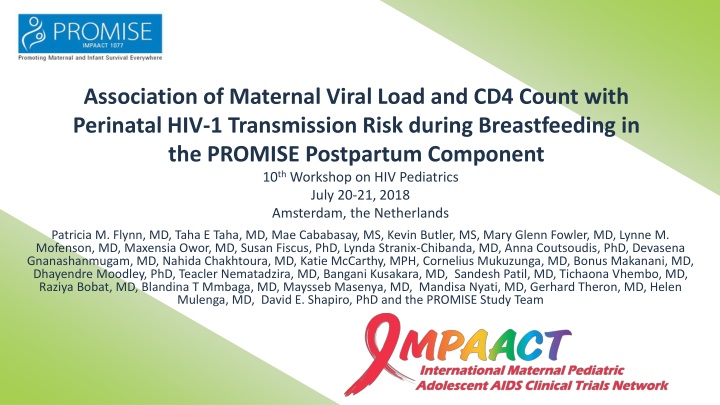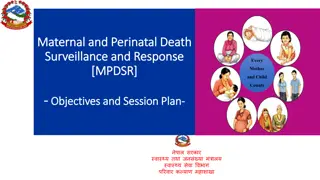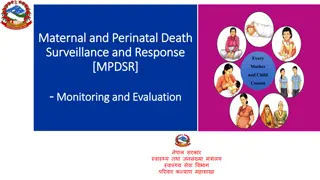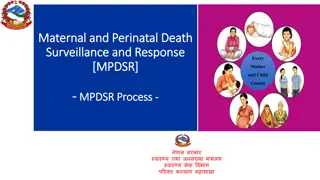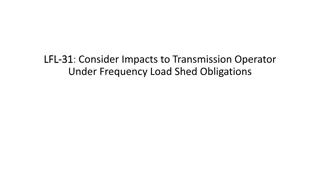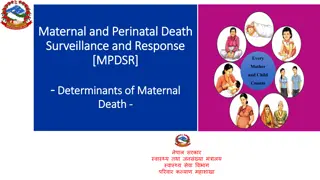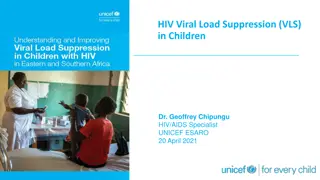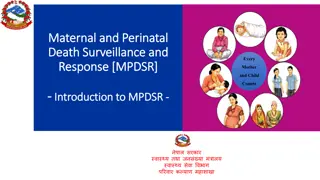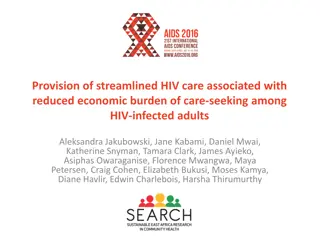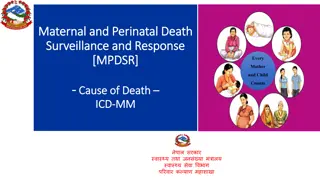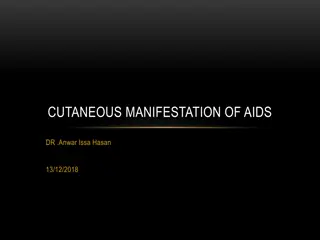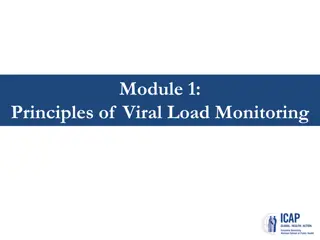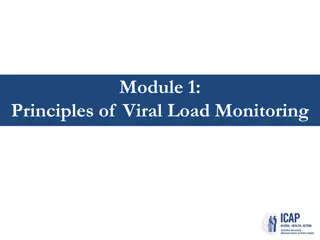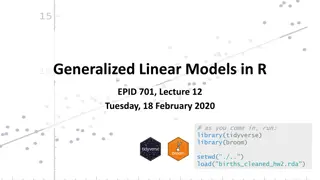Association of Maternal Viral Load and CD4 Count with Perinatal HIV-1 Transmission Risk
Increased maternal viral load (MVL) and decreased CD4 cell counts have been linked to higher risks of perinatal and postnatal HIV-1 transmission during breastfeeding. The PROMISE Postpartum Component study examines the association between these factors and transmission risk, providing insights into strategies for preventing mother-to-child transmission of HIV.
Uploaded on Oct 06, 2024 | 1 Views
Download Presentation

Please find below an Image/Link to download the presentation.
The content on the website is provided AS IS for your information and personal use only. It may not be sold, licensed, or shared on other websites without obtaining consent from the author.If you encounter any issues during the download, it is possible that the publisher has removed the file from their server.
You are allowed to download the files provided on this website for personal or commercial use, subject to the condition that they are used lawfully. All files are the property of their respective owners.
The content on the website is provided AS IS for your information and personal use only. It may not be sold, licensed, or shared on other websites without obtaining consent from the author.
E N D
Presentation Transcript
Association of Maternal Viral Load and CD4 Count with Perinatal HIV-1 Transmission Risk during Breastfeeding in the PROMISE Postpartum Component 10th Workshop on HIV Pediatrics July 20-21, 2018 Amsterdam, the Netherlands Patricia M. Flynn, MD, Taha E Taha, MD, Mae Cababasay, MS, Kevin Butler, MS, Mary Glenn Fowler, MD, Lynne M. Mofenson, MD, Maxensia Owor, MD, Susan Fiscus, PhD, Lynda Stranix-Chibanda, MD, Anna Coutsoudis, PhD, Devasena Gnanashanmugam, MD, Nahida Chakhtoura, MD, Katie McCarthy, MPH, Cornelius Mukuzunga, MD, Bonus Makanani, MD, Dhayendre Moodley, PhD, Teacler Nematadzira, MD, Bangani Kusakara, MD, Sandesh Patil, MD, Tichaona Vhembo, MD, Raziya Bobat, MD, Blandina T Mmbaga, MD, Maysseb Masenya, MD, Mandisa Nyati, MD, Gerhard Theron, MD, Helen Mulenga, MD, David E. Shapiro, PhD and the PROMISE Study Team
DISCLOSURES Dr. Flynn is a paid consultant for Merck and receives royalties from Up to Date.
Background Increased maternal viral load (MVL) and decreased CD4 cell counts (CD4) have been associated with increased risk of perinatal and postnatal HIV-1 transmission Maternal Health (after breastfeeding cessation) Women with CD4 350 cells/mm3 Antepartum (14 wk-term) Postpartum Labor & Delivery (for duration of breastfeeding) Continue ART R A N D O M I Z E ZDV-ART Maternal TDF/FTC/LPVr (mART) ZDV/3TC/LPVr R A N D O M I Z E R A N D O M I Z E Stop ART TDF-ART TDF/FTC/LPVr Infant NVP ZDV + sdNVP (iNVP) ZDV Alone Late Presenting Mothers 3
PROMISE Postpartum Component Eligible mother-infant (M-I) pairs (maternal CD4 350 cells/mm3 or country-specific level and infant HIV-1 NAT negative and > 2 kg)were randomized at 6 14 days postpartum to a maternal three-drug ART regimen (TDF/FTC/LPVr preferred, mART) arm or infant nevirapine (iNVP) arm Infants in the mART arm also received NVP for 6 weeks Late-presenting women were enrolled during labor or within 6 days of delivery after assuring the mother s CD4 count met eligibility criteria and infant had a negative HIV-1 NAT Maternal prophylaxis during breastfeeding (TDF/FTC/LPVr) Component Postpartum Screening Randomize Infant prophylaxis during breastfeeding (NVP) 4
PROMISE Postpartum Component 2,431 M-I pairs were randomized at 6- 14 days postpartum to mART (n=1,220) or iNVP (n=1,211) at 14 sites in 7 countries 95% of the mothers had been enrolled in the antepartum component (42% ZDV and 53% mART) India 3% Zimbabwe 22% Malawi 32% Zambia 2% Randomized regimens were continued until 18 months postpartum, unless stopped earlier due to cessation of breastfeeding, infant HIV-1 infection, or toxicity Uganda 16% Tanzania 2% South Africa 23% 5
PROMISE Postpartum Component, Primary Analysis Findings The primary analysis of the postpartum component has been reported (J Acquir Immune Defic Syndr. 2018 Apr 1;77(4):383-392) o Both regimens were safe and associated with very low postpartum transmission rates (mART , 0.57% and iNVP, 0.58%; hazard ratio [HR] 1.0, 96% repeated confidence interval 0.3-3.1) o Infant HIV-1-free survival was high (97.1%, mART and 97.7%, iNVP, at 24 months) This planned secondary analysis examines the relationship between MVL and CD4 with HIV-1 transmission during breastfeeding 6
Methods Study Evaluations Maternal Viral Load Entry (6-14 days postpartum), weeks 6, 14, 26, and 50 postpartum Maternal CD4 Entry, weeks 14, 26, 38, 50 postpartum Infant HIV-1 NAT Entry (6-14 days postpartum), week 6, every 4 weeks until week 26, then every 12 weeks Infant infection was defined as a positive HIV-1 NAT at any two post-entry timepoints The associations of baseline and time-varying MVL (<1000 or 1,000 copies/ml) and CD4 (< 500 or 500 cells/mm3) with transmission risk were assessed using proportional hazards regression models and adjustment for randomization to the mART arm during the antepartum component of PROMISE 7
Analysis For analyses using time-varying MVL and CD4, each treatment arm was analyzed separately because the post-randomization visits showed little overlap between the two arms with respect to MVL and CD4 cell count Log 10 HIV RNA CD4 cell/mm3 8
Results Baseline MVL and CD4 cell count by Treatment Arm mART iNVP n=1,220 n=1,211 Baseline Maternal Viral Load < 1,000 copies/mL 911 (75%) 814 (67%) 1,000 copies/mL 309 (25%) 397 (33%) Baseline CD4 count < 500 cells/mm3 162 (13%) 170 (14%) 500 cells/mm3 1,058 (87%) 1,041 (86%) Baseline MVL (p=0.11) and CD4 cell count (p=0.51) were not significantly associated with infant HIV-1 transmission 9
Results, continued Time-varying MVL was significantly associated with infant HIV-1 infection in the mART arm but not in the iNVP arm Time-varying CD4 was significantly associated with infant HIV-1 infection in the mART arm but not in the iNVP arm Adjusting for whether or not the mother was randomized to the mART arm in the antepartum component of PROMISE component did not change these findings Hazards Ratio (95% Confidence Interval) mART iNVP Time- varying MVL 13.96 1.04 (3.12-62.45) (0.20-5.39) Time- varying CD4 0.18 0.38 (0.03-0.93) (0.08-1.77 10
Results, continued When both time-varying MVL and time-varying CD4 were in used in the model for infant HIV-1 infection in the mART arm, only MVL remained associated with infant HIV-1 infection (hazard ratio (95% CI): 11.57 (2.45,54.68)) and there was no association with maternal CD4 (hazard ratio (95% CI): 0.34 (0.06,1.88)) Adjusting for whether or not the mother was randomized to the mART arm in the antepartum component of PROMISE did not change these findings 11
Infant HIV-1 Infections There were seven infants with HIV-1 infection in each treatment group mART iNVP HIV-1 infections n=7 n=7 Median infant age at first positive HIV- 1 NAT 38 weeks 26 weeks (range, 13-50 weeks) (range, 6-74 weeks) MVL closest and prior to first positive infant HIV- 1 NAT Not detected 52,002 copies/mL 815 153,963 copies/mL 12
Results, continued In the mART arm there were two infected infant cases where MVL was undetectable or < 40 copies/mL in assessments prior to first positive infant HIV-1 NAT 38 weeks 13 weeks < 40 copies/mL Not detected 13
Conclusions In the iNVP arm, time-varying MVL and CD4 were not significantly associated with HIV-1 transmission during breastfeeding. However, in the mART arm, increased MVL and decreased CD4 during breastfeeding were associated with increased risk of infant HIV-1 infection Two infant transmissions were observed following periods of MVL that were < 40 copies/mL These data emphasize the important role of adherence to mART in controlling MVL and preventing infant HIV-1 infection and suggest that iNVP should be considered in situations with documented poor maternal ART adherence 14
Acknowledgements The PROMISE protocol team gratefully acknowledges the dedication and commitment of the more than 3,500 mother-infant pairs without whom this study would not have been possible. Sponsors: US National Institutes of Health (K Klingman, R Browning, L Purdue, G Siberry); Protocol Chair and Vice Chairs: J McIntyre, T Chipato; Operations Center: M Allen, A Coletti, K George, M Valentine, V Toone; Statistical and Data Management Center: T Fenton, K Butler, M Qin, C Marr, C Tierney, S Brummel, K Angelidou, M Basar, L Marillo, A Manzella, A Zadzilka; Laboratory Center: A Loftis; CMC: D Bhattacharya, R Hoffman, A Gupta, G Theron, B Chi, P Flynn, J Currier Overall support for the International Maternal Pediatric Adolescent AIDS Clinical Trials Network (IMPAACT) was provided by the National Institute of Allergy and Infectious Diseases (NIAID) with co-funding from the Eunice Kennedy Shriver National Institute of Child Health and Human Development (NICHD) and the National Institute of Mental Health (NIMH), all components of the National Institutes of Health (NIH), under Award Numbers UM1AI068632 (IMPAACT LOC), UM1AI068616 (IMPAACT SDMC) and UM1AI106716 (IMPAACT LC), and by NICHD contract number HHSN275201800001I. The content is solely the responsibility of the authors and does not necessarily represent the official views of the NIH. 15
